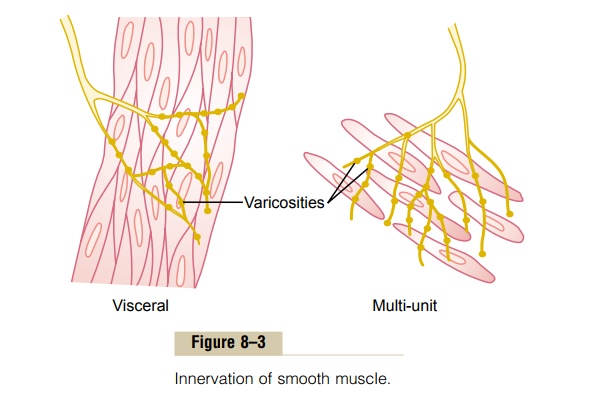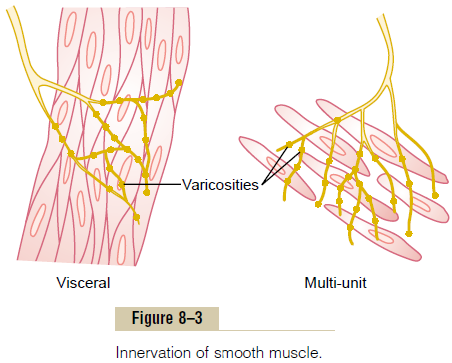Chapter: Medical Physiology: Contraction and Excitation of Smooth Muscle
Neuromuscular Junctions of Smooth Muscle

Neuromuscular Junctions of Smooth Muscle
Physiologic Anatomy of Smooth Muscle Neuromuscular Junc-tions. Neuromuscular junctions of the highly struc-tured type found on skeletal muscle fibers do not occur in smooth muscle. Instead, the autonomic nerve fibers that innervate smooth muscle generally branch
In most instances, these fibers do not make direct contact with the smooth muscle fiber cell membranes but instead form so-called diffuse junc-tions that secrete their transmitter substance into thematrix coating of the smooth muscle often a few nanometers to a few micrometers away from the muscle cells; the transmitter substance then diffuses to the cells. Furthermore, where there are many layers of muscle cells, the nerve fibers often innervate only the outer layer, and muscle excitation travels from this outer layer to the inner layers by action potential con-duction in the muscle mass or by additional diffusion of the transmitter substance.
The axons that innervate smooth muscle fibers do not have typical branching end feet of the type in the motor end plate on skeletal muscle fibers. Instead, most of the fine terminal axons have multiple vari-cosities distributed along their axes. At these points theSchwann cells that envelop the axons are interruptedso that transmitter substance can be secreted through the walls of the varicosities. In the varicosities are vesi-cles similar to those in the skeletal muscle end plate that contain transmitter substance. But, in contrast to the vesicles of skeletal muscle junctions, which always contain acetylcholine, the vesicles of the autonomic nerve fiber endings contain acetylcholine in some fibers and norepinephrine in others—and occasionally other substances as well.

In a few instances, particularly in the multi-unit type of smooth muscle, the varicosities are separated from the muscle cell membrane by as little as 20 to 30 nanometers—the same width as the synaptic cleft that occurs in the skeletal muscle junction. These are calledcontact junctions, and they function in much the sameway as the skeletal muscle neuromuscular junction; the rapidity of contraction of these smooth muscle fibers is considerably faster than that of fibers stimulated by the diffuse junctions.
Excitatory and Inhibitory Transmitter Substances Secreted at the Smooth Muscle Neuromuscular Junction. The mostimportant transmitter substances secreted by theautonomic nerves innervating smooth muscle are acetylcholine and norepinephrine, but they are neversecreted by the same nerve fibers. Acetylcholine is an excitatory transmitter substance for smooth muscle fibers in some organs but an inhibitory transmitter for smooth muscle in other organs. When acetylcholine excites a muscle fiber, norepinephrine ordinarily inhibits it. Conversely, when acetylcholine inhibits a fiber, norepinephrine usually excites it.
But why these different responses? The answer is that both acetylcholine and norepinephrine excite or inhibit smooth muscle by first binding with a receptorprotein on the surface of the muscle cell membrane.Some of the receptor proteins are excitatory receptors,whereas others are inhibitory receptors. Thus, the type of receptor determines whether the smooth muscle is inhibited or excited and also determines which of the two transmitters, acetylcholine or norepinephrine, is effective in causing the excitation or inhibition.
Related Topics